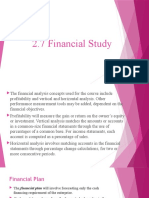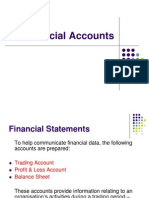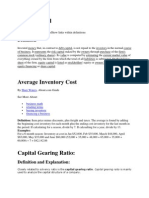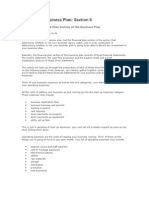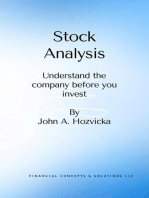0 ratings0% found this document useful (0 votes)
16 viewsFinancial Plan2
Financial Plan2
Uploaded by
raazoo19Total capital requirements include fixed assets, pre-operating expenses, and working capital. The document determines if a loan is needed to finance the total capital required. It also identifies what security can be provided to a bank. Unit selling price is calculated to determine expected sales and profit. Cash flow, profit/loss, and balance sheet statements are analyzed. Return on investment and break-even point are calculated. Feasibility of the project is determined by assessing profitability, supply issues, and impacts of unrealized sales forecasts.
Copyright:
© All Rights Reserved
Available Formats
Download as PPT, PDF, TXT or read online from Scribd
Financial Plan2
Financial Plan2
Uploaded by
raazoo190 ratings0% found this document useful (0 votes)
16 views6 pagesTotal capital requirements include fixed assets, pre-operating expenses, and working capital. The document determines if a loan is needed to finance the total capital required. It also identifies what security can be provided to a bank. Unit selling price is calculated to determine expected sales and profit. Cash flow, profit/loss, and balance sheet statements are analyzed. Return on investment and break-even point are calculated. Feasibility of the project is determined by assessing profitability, supply issues, and impacts of unrealized sales forecasts.
Original Description:
financial
Copyright
© © All Rights Reserved
Available Formats
PPT, PDF, TXT or read online from Scribd
Share this document
Did you find this document useful?
Is this content inappropriate?
Total capital requirements include fixed assets, pre-operating expenses, and working capital. The document determines if a loan is needed to finance the total capital required. It also identifies what security can be provided to a bank. Unit selling price is calculated to determine expected sales and profit. Cash flow, profit/loss, and balance sheet statements are analyzed. Return on investment and break-even point are calculated. Feasibility of the project is determined by assessing profitability, supply issues, and impacts of unrealized sales forecasts.
Copyright:
© All Rights Reserved
Available Formats
Download as PPT, PDF, TXT or read online from Scribd
Download as ppt, pdf, or txt
0 ratings0% found this document useful (0 votes)
16 views6 pagesFinancial Plan2
Financial Plan2
Uploaded by
raazoo19Total capital requirements include fixed assets, pre-operating expenses, and working capital. The document determines if a loan is needed to finance the total capital required. It also identifies what security can be provided to a bank. Unit selling price is calculated to determine expected sales and profit. Cash flow, profit/loss, and balance sheet statements are analyzed. Return on investment and break-even point are calculated. Feasibility of the project is determined by assessing profitability, supply issues, and impacts of unrealized sales forecasts.
Copyright:
© All Rights Reserved
Available Formats
Download as PPT, PDF, TXT or read online from Scribd
Download as ppt, pdf, or txt
You are on page 1of 6
Financial plan
What is the total capital requirement
Is loan needed
What security can be given to bank
What is unit selling price of the
product
What does profit and loss statement
indicate
What does the cash flow statement
indicate
What does balance sheet indicate
What is break even point
What is the return on investment (ROI)
Is the project feasible
Total capital requirement
Total capital requirement is
composed of three items:
Fixed
assets: building, machinery,
furniture, fixtures , etc.
Pre-operating expenses: these
include registration fees, training
cost, cost of preparing business
plan, etc.
Working capital: the amount of
money permanently needed in
cash or kind to keep business
operating.
Loan need
Determine the total capital
requirement and see if the
amount required is too much for
you to finance on your own. If
this is the case then loan is
needed.
Unit selling price
To Calculate the expected sales
for preparing profit and loss
statement, determine the unit
selling price of the product.
Return on investment
To calculate ROI;
divide earning before tax (net
profit) by the total capital
requirement.
Feasibility of the project
This section deal with the
questions like:
Is
the profit on the first year
sufficient to meet the loan and
interest payment
Can raw materials supply problem
overcome
What happens if sales forecast is
only 80% realised.
You might also like
- Business Plan Financial ProjectionsDocument5 pagesBusiness Plan Financial ProjectionsPrem Singh Dhankhar100% (5)
- Understanding Financial Statements (Review and Analysis of Straub's Book)From EverandUnderstanding Financial Statements (Review and Analysis of Straub's Book)Rating: 5 out of 5 stars5/5 (5)
- Sumita Oliya Internship ReportDocument20 pagesSumita Oliya Internship Reportraazoo19No ratings yet
- HSBC Business PlanDocument12 pagesHSBC Business PlanStan RoperNo ratings yet
- Finance For Non FinanceDocument32 pagesFinance For Non FinanceAmol MJ100% (1)
- Financial PlanDocument9 pagesFinancial PlanIndra Kusuma AdiNo ratings yet
- The Financial Plan: Serjoe Orven Gutierrez - Mmed ReporterDocument41 pagesThe Financial Plan: Serjoe Orven Gutierrez - Mmed ReporterSerjoe GutierrezNo ratings yet
- Projected Cash Flow StatementDocument6 pagesProjected Cash Flow StatementIqtadar AliNo ratings yet
- How To Write A Traditional Business Plan: Step 1Document5 pagesHow To Write A Traditional Business Plan: Step 1Leslie Ann Elazegui UntalanNo ratings yet
- Start Up Capital (Start Up Budget) and Its SourcesDocument19 pagesStart Up Capital (Start Up Budget) and Its SourcesJaymilyn Rodas SantosNo ratings yet
- Doing Financial ProjectionsDocument6 pagesDoing Financial ProjectionsJitendra Nagvekar50% (2)
- Business Plan Template v4 01092009Document13 pagesBusiness Plan Template v4 01092009Flloyd JardelezaNo ratings yet
- Financial Plan OutlineDocument18 pagesFinancial Plan OutlineRenalyn GomezNo ratings yet
- Small Business Owner S HandbookDocument18 pagesSmall Business Owner S HandbookAla'a AbdullaNo ratings yet
- Feasibility StudyDocument22 pagesFeasibility StudyKayo AbebeNo ratings yet
- Financial ProjectionsDocument8 pagesFinancial ProjectionsNhã LinhNo ratings yet
- Industrial Products CorporationDocument4 pagesIndustrial Products CorporationFahmi A. Mubarok100% (1)
- Business Plan: Business Planning For Start-UpsDocument7 pagesBusiness Plan: Business Planning For Start-UpsartteffNo ratings yet
- 2.7 Lesson 7Document13 pages2.7 Lesson 7Dark PrincessNo ratings yet
- Balance Sheet Analysis PPT at Bec Doms BDocument25 pagesBalance Sheet Analysis PPT at Bec Doms BAARTI GUPTANo ratings yet
- Homework 1 Directions - ModB2015Document3 pagesHomework 1 Directions - ModB2015obliv110% (1)
- Lesson 4 Part 1 Budget PreparationDocument19 pagesLesson 4 Part 1 Budget PreparationmariannedakilaNo ratings yet
- Business Financial Plan PPTDocument16 pagesBusiness Financial Plan PPTMJNo ratings yet
- Business-Plan-Financials TeDocument5 pagesBusiness-Plan-Financials TesamanthatianelaNo ratings yet
- Small Business Owner'S Handbook: Financial Planning For Small BusinessesDocument18 pagesSmall Business Owner'S Handbook: Financial Planning For Small BusinessesKevin_PNo ratings yet
- Final Accounts-Sole TradersDocument35 pagesFinal Accounts-Sole TradersBhavik Shah100% (1)
- Cost of Project & Break-Even AnalysisDocument28 pagesCost of Project & Break-Even AnalysisRs rsNo ratings yet
- Finance For Non FinanceDocument32 pagesFinance For Non FinanceZhuwenyuanNo ratings yet
- FUNDAMENTAL ANALYSIS NotesDocument8 pagesFUNDAMENTAL ANALYSIS NotesBalaji GaneshNo ratings yet
- Titan Basic and Competition Strategy GuideDocument12 pagesTitan Basic and Competition Strategy GuideArgo VirgiawanNo ratings yet
- Chapter 3: Feasibility AnalysisDocument25 pagesChapter 3: Feasibility AnalysisGenevieve Amar Delos SantosNo ratings yet
- Glossary of ValuationDocument7 pagesGlossary of Valuationveda20100% (1)
- Basic Business Financial ConceptsDocument6 pagesBasic Business Financial ConceptsShalabh BansalNo ratings yet
- Financial Plan LectureDocument5 pagesFinancial Plan LectureJcTYTNo ratings yet
- Financial Ratios and Comparables AnalysisDocument12 pagesFinancial Ratios and Comparables Analysisdtracy4No ratings yet
- Project ManagementDocument94 pagesProject ManagementJyoti Prakash BiswalNo ratings yet
- Activity Sheet in Business Enterprise SimulationDocument8 pagesActivity Sheet in Business Enterprise SimulationAimee Lasaca100% (1)
- VCE Summer Internship Program 2021: Tushar Gupta 1 Equity ResearchDocument7 pagesVCE Summer Internship Program 2021: Tushar Gupta 1 Equity ResearchTushar GuptaNo ratings yet
- Technical Studies 2019-1 V2Document4 pagesTechnical Studies 2019-1 V2J DNo ratings yet
- Business Plan: The Standard Font For LEA Is Garamond 12Document13 pagesBusiness Plan: The Standard Font For LEA Is Garamond 12papimorokaNo ratings yet
- Equity Capital: Shari WatersDocument6 pagesEquity Capital: Shari WatersMirza ShoaibbaigNo ratings yet
- Lecture 2728 Prospective Analysis Process of Projecting Income Statement Balance SheetDocument36 pagesLecture 2728 Prospective Analysis Process of Projecting Income Statement Balance SheetRahul GautamNo ratings yet
- BudgetDocument5 pagesBudgetmuktaNo ratings yet
- Slides 03 - Business Plan DevelopmentDocument21 pagesSlides 03 - Business Plan DevelopmentKazun KzNo ratings yet
- TEMPLATE Financial Projections WorkbookDocument22 pagesTEMPLATE Financial Projections WorkbookFrancois ChampenoisNo ratings yet
- FABM 2nd Sem Long QuizzesDocument8 pagesFABM 2nd Sem Long QuizzesJeamie SayotoNo ratings yet
- 6. The Financial PlanDocument12 pages6. The Financial Plannickypali01No ratings yet
- Final 3- Financial Plan (Updated)Document32 pagesFinal 3- Financial Plan (Updated)Mahbuba Afroze ChowdhuryNo ratings yet
- Entrepreneurship Chapter 10 - The Financial PlanDocument2 pagesEntrepreneurship Chapter 10 - The Financial PlanSoledad Perez100% (6)
- The Budgeting Process in More Detail (Problem On Last Page)Document5 pagesThe Budgeting Process in More Detail (Problem On Last Page)Rafael OcampoNo ratings yet
- Practice Questions For End-Term ExamDocument32 pagesPractice Questions For End-Term Examfpb2426.196.christyNo ratings yet
- Corporate Financial Analysis NotesDocument19 pagesCorporate Financial Analysis NotesWinston WongNo ratings yet
- 2012 Business Concept OutlineDocument8 pages2012 Business Concept OutlineJohnBandaNo ratings yet
- Net Block DefinitionsDocument16 pagesNet Block DefinitionsSabyasachi MohapatraNo ratings yet
- Examples of Non-Operating Revenues and ExpensesDocument7 pagesExamples of Non-Operating Revenues and ExpensesVj Ram Asriya RaoNo ratings yet
- Fin622 QuizDocument59 pagesFin622 Quizwqas_akramNo ratings yet
- Module 3 Fundamental Analysis 1Document27 pagesModule 3 Fundamental Analysis 1wijayaarieNo ratings yet
- Earnings and Cash Flow Analysis: SlidesDocument6 pagesEarnings and Cash Flow Analysis: Slidestahera aqeelNo ratings yet
- Writing The Business PlanDocument8 pagesWriting The Business PlanIngrid Yaneth SalamancaNo ratings yet
- 4 Quarter 2074/2075 (14 April 2018 - 16 July 2018) : ST THDocument2 pages4 Quarter 2074/2075 (14 April 2018 - 16 July 2018) : ST THraazoo19No ratings yet
- Investor'S Preference in Stock Market Participation A Study of Nepalese Retail Investor'SDocument1 pageInvestor'S Preference in Stock Market Participation A Study of Nepalese Retail Investor'Sraazoo19No ratings yet
- Questionnaire SampleDocument7 pagesQuestionnaire Sampleraazoo19100% (1)
- Motivational Training: Program OutlineDocument1 pageMotivational Training: Program Outlineraazoo19No ratings yet
- HRM 4 UnitDocument10 pagesHRM 4 Unitraazoo19No ratings yet
- HRM Unit 2Document9 pagesHRM Unit 2raazoo19No ratings yet
- HRM Unit 1Document49 pagesHRM Unit 1raazoo19No ratings yet
- Introduction SlideDocument32 pagesIntroduction Slideraazoo19No ratings yet
- SamplingDocument89 pagesSamplingraazoo19No ratings yet
- HRM NoteDocument60 pagesHRM Noteraazoo19No ratings yet
- Negative Motivation Concerns With Influencing The Behavior ofDocument5 pagesNegative Motivation Concerns With Influencing The Behavior ofraazoo19No ratings yet
- Simple Random 2. Systematic 3. Stratified 4. Cluster 5. Multi-StageDocument9 pagesSimple Random 2. Systematic 3. Stratified 4. Cluster 5. Multi-Stageraazoo19No ratings yet
- Meaning and Importance OfresearchDocument19 pagesMeaning and Importance Ofresearchraazoo19No ratings yet
- Research Method AllDocument90 pagesResearch Method Allraazoo19No ratings yet
- Problems of Small Business: S.no. Parameters Small LargeDocument2 pagesProblems of Small Business: S.no. Parameters Small Largeraazoo19No ratings yet
- Functional StrategyDocument2 pagesFunctional Strategyraazoo19No ratings yet
- Research Unit FourDocument7 pagesResearch Unit Fourraazoo19No ratings yet
- Unit III Supply Chain DriversDocument13 pagesUnit III Supply Chain Driversraazoo19No ratings yet
- Small Business Entrepreneurship: The Meaning of Small Business: Small Business Means Small in Operation, EmploymentDocument1 pageSmall Business Entrepreneurship: The Meaning of Small Business: Small Business Means Small in Operation, Employmentraazoo19No ratings yet
- The Process of Setting Up A Small BusinessDocument1 pageThe Process of Setting Up A Small Businessraazoo19No ratings yet
- 2nd Sem RoutineDocument1 page2nd Sem Routineraazoo19No ratings yet
- Capital Investment Is Low1Document4 pagesCapital Investment Is Low1raazoo19No ratings yet
- Customers Are Always The KingDocument2 pagesCustomers Are Always The Kingraazoo19No ratings yet
- Asian TQM Final QnsDocument1 pageAsian TQM Final Qnsraazoo19No ratings yet
- Generation of Active Leaders (GOAL) : Evaluation FormDocument2 pagesGeneration of Active Leaders (GOAL) : Evaluation Formraazoo19No ratings yet


















